
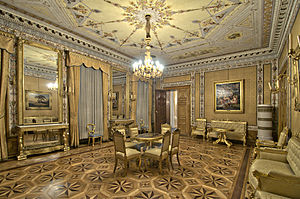
Wiesbaden City Palace (German: Stadtschloss Wiesbaden or Wiesbadener Stadtschloss) is a neo-classical building in the center of Wiesbaden, Germany. It was completed in 1841 as the principal city residence of the Dukes of Nassau. The palace has several wings, 145 rooms, and is architecturally integrated with a group of ancillary buildings constructed both before and after it was built. With ornate towers, gables and a slate roof laid in herringbone patterns, the three-story complex lends charm and its name to the central square of Wiesbaden: Palace Square (German: Schloßplatz).
The Palace has had a turbulent history. After withstanding the Revolutions of 1848 and annexation by Prussia in 1866, it has served variously as a second home of the German Emperors, a gathering place for soldiers and workers during the German Revolution of 1918–1919, a museum, and a military headquarters for both the Wehrmacht and Allied occupation forces. Damaged during World War II, the Palace has since been restored and portions modernized. Since 1946, it has been the seat of the State Parliament of Hesse (German: Hessischer Landtag). A new Parliamentary Chamber was added to the complex in 2008.
History
Early beginnings
The site where the City Palace now stands has been the center of political power in Wiesbaden for centuries. It was first occupied by a castle from the Early Middle Ages around which the medieval city developed. By 1236 the Counts of Nassau were already in residence, when there is a record of Holy Roman Emperor Friedrich II celebrating Pentecost in the castle church. During this time the city enjoyed the status of Reichsstadt (Free Imperial City), but only briefly. In subsequent wars Wiesbaden was completely destroyed and rebuilt at least three times. During the Renaissance the city became a notable spa town, and Philipp Ludwig III commissioned construction of a New City Palace, completed in 1599. This renewal was not to last, however. The lands of the House of Nassau were reshuffled in inheritances and as lines died out. The Thirty Years' War again devastated the city, with chronicles recording that by 1648 it had barely 40 residents left. In the 1700s, Schloss Biebrich (the "Versailles on the Rhine" on the outskirts of Wiesbaden) became a principal residence of the line of Nassau-Idstein and the City Palace fell into disuse. Little is known about the extent of the old original Castle, but remains of a tower dating back as early as the Frankish period (481–800 CE) were discovered in 1952 during reconstruction of adjacent buildings damaged in the Second World War.
City Residence of the Duchy of Nassau 1841–1866

In 1806, the counties of Nassau-Usingen and Nassau-Weilburg merged to form the Duchy of Nassau at the insistence of Napoleon. Frederick Augustus, Duke of Nassau, became the ducal head of state. After the defeat of Napoleon, the Duchy of Nassau joined the German Confederation at the Congress of Vienna in 1815. The capital moved from Weilburg to Wiesbaden and the city became the ducal residence. When Frederick died childless in 1816, the dukedom was transferred to the line of Nassau-Weilburg. His cousin Wilhelm of Nassau-Weilburg became Wilhelm, Duke of Nassau and moved from Weilburg into Schloss Biebrich on the outskirts of Wiesbaden.
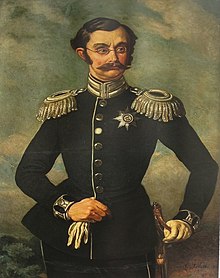
By 1826, extensive building began to give the new capital city a magnificent appearance and in 1830 plans were laid to move the ducal residence into the city. Initially, a site on the Luisenplatz was considered, which was then still on the outskirts. However, the Duke felt it important to live amidst his subjects, so a central location on the Market Square was decided upon. In 1835, Wilhelm I engaged his Senior Architect Georg Moller to design the new City Palace. Several buildings were acquired on the north side of the square and in 1837 the foundation stone was laid. Duke Wilhelm would not live to its completion; He died of a stroke on 20 August 1839 while "taking the cure" at Bad Kissingen. His son Adolph I, Duke of Nassau became the Palace's first and only ducal resident in 1841. He lived there during the winter and in summers resided at Schloss Biebrich.
During the Revolutions of 1848 a national uprising began in many German States. On 4 March 1848 it spread to the Duchy, when a third of the male population of some 30,000 angry citizens gathered in front of the City Palace to demand confirmation of the Nine Claims of Nassau, an early Bill of Rights. With the crowd threatening to storm the Palace, Adolph rushed back to Wiesbaden from Berlin, where he had been consulting on the crisis. He rescued his monarchy at the last minute by walking, unguarded and in uniform, through the crowds from the railroad station to the City Palace. He announced his assent to their demands from the balcony and the menacing riot turned into a celebration. In April 1848, the Duke appointed the liberal politician August Hergenhahn as his Prime Minister and several advanced laws were enacted. While Adolph did not fulfill all his promises, and some were not adopted until 1861, by enacting important reforms he enjoyed a longer reign and the respect of the population.
Prussian Royal Residence 1866–1918

In 1866, Adolph fatefully supported the Austrian side in the Second Austro-Prussian War, which lost. The Kingdom of Prussia annexed the Duchy as a war prize, sent the Duke into exile and took possession of the Wiesbaden City Palace. It was then used as a residence by Emperor Wilhelm I and the adjacent Kaiser-Wilhelm Sanatorium, built in 1871 as a military hospital, was named in his honor. Wilhem's grandson, Kaiser Wilhelm II, then made the palace a regular summer home. He resided there annually with his staff and members of the Hohenzollern family. Wiesbaden experienced tremendous growth and became an international resort, with the population increasing from 35,500 in 1871 to 100,000 by 1905. Near the Palace numerous new important buildings were constructed, including a New Town Hall (1897), the Hessian State Theater (1894), the Kurhaus (1907) and the Central Railway Station (1906).
Military Administrative Center 1918–1946
After Germany's defeat in World War I and the monarchy collapsed, the palace was used for a variety of purposes. It initially became home to the local Workers' and Soldiers' Council during the German Revolution of 1918-1919. Later it was used as the supreme headquarters of the French Occupation Armies during the Allied Occupation of the Rhineland. In 1925, the palace became the headquarters of British Army of the Rhine. After the withdrawal of occupying forces in 1930, the building came into the possession of the Prussian State Administration of Palaces (German: Preußischen Staatlichen Schlösserverwaltung) and was converted into a museum.
During World War II, the building complex became the Wehrmacht's General Headquarters for Wehrkreis (Military District) XII under the command of General der Infanterie Walther Schroth. This region included the Eifel, part of Hesse, the Palatinate, and the Saarland. After Germany's victory in the Battle of France in 1940, Wehrkreis XII was expanded to include the Grand Duchy of Luxembourg and the Lorraine Region, including Nancy. In the immediate aftermath of World War II, the US Army used the partially ruined building as its headquarters.
Seat of the Landtag since 1946
In 1946, Wiesbaden became the capital of the newly created State of Hesse and the Palace became the seat of the Hessian Landtag. The Landtag met for the first time in the largest room of the House, the Music Hall, on 1 December 1946. In 1959 the former Royal Riding Hall in the courtyard was demolished and a new Plenary Chamber built in its place. The Palace's historic rooms were preserved and used for receptions. Ancillary buildings around the Palace were redeveloped for use by the Landtag administration. In 1975 the editorial staff of Hessian Radio (German: Hessischer Rundfunk) moved into the complex to better cover State politics and also opened a TV studio there.
In the late 1990s plans began to construct a new building to replace the outdated Plenary Chamber. The Bundestag wanted to build a transparent glass Hall on the Schlossplatz between the Palace and the Marktkirche in the architectural style of the Federal buildings in Bonn. That project was halted due to cost as well as protests from the population about the building's appropriateness. The Federal Design Office then advertised an architectural competition and Waechter + Waechter of Darmstadt won. Their proposal for a low-profile building inside the courtyard behind the Palace's facade was designed to preserve the historic character of the Schloßplatz. This was approved and the old Plenary Chamber was demolished in 2004. The City Palace became a construction site for the next four years and on 4 April 2008 parliament moved into its new home.
Architecture
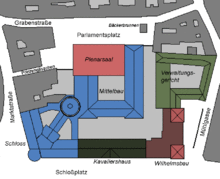
Building complex
Today the Hessian Landtag occupies the original Ducal Palace and several adjacent buildings aligned to the Schloßplatz. These include the Kavaliershaus and former Kaiser-Wilhelms Sanatorium, today referred to as the Wilhelmsbau. Inside the inner courtyard of the Castle is the Plenary Chamber of the Landtag, opened in 2008. All located in the Historical Pentagon.
Ducal palace
Structure and exterior

The main neo-classical palace building consists of an outwardly simple but elegant three-story structure with two wings arranged in a blunt angle. Its most prominent architectural feature is the connecting corner between the two wings, which takes the form of a cylinder. Here the architect Georg Moller, a disciple of Friedrich Weinbrenner, and master builder Richard Goerz placed the main entrance. Both wings hold up a balcony on the first floor (for Americans, the second floor). This skirts around the cylinder on six columns, above which the coat of arms of the House of Nassau is prominently displayed. The facades are covered in white stucco, with ornate cornices and window frames standing out from the background in grey. Smaller windows are arranged in a row above the upper eaves, behind which were once the rooms for domestic staff. A third diagonal wing, housing the main staircase (German: Haupttreppenhaus), bisects the angle between the two main wings. This connects to the Middle Building (German: Mittelbau) which forms a central courtyard. A conservatory or "winter garden", in the shape of an arc, connects the ends of all three wings. This intersection forms two triangular-shaped inner courtyards. In order to reinforce the impression of space, the building's 145 rooms were arranged such that they could only be reached over long distances.
Interiors

The main entrance of the corner tower connects to the so-called Small Rotunda, with a mosaic parquet floor of eight different woods, mother-of-pearl and brass. This further leads through the diagonal wing to the main staircase, behind which is a large Dome Hall and the Mittelbau. The Right and Left wings accommodated the luxurious main rooms of the ducal apartments, decorated in exotic woods on doors, floors and furniture. Many statues adorn the corridors and gold-plated bronze candlesticks were placed throughout the rooms. Painted wallpapers in various motifs of the day, including recently exposed wall paintings of Pompeii, are especially precious. During World War II the interiors of the right wing, consisting of the wardrobe and bath of the Duchess, were completely destroyed.
Left wing
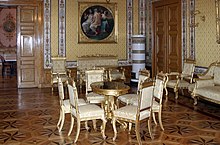
The most impressive surviving rooms of the Palace are on the 1st floor in the left wing. Here is the Red Salon, with walls covered in red silk wallpaper between stucco marble. The room has elaborate ceiling decoration, parquet floors, and paintings in the romantic style. This room connects to the Yellow Salon, the former breakfast room. It is in a similar design to the Red Salon, except the furniture is gold-plated and the wall treatments are in yellow. An adjoining small hall extends over two floors. These walls are decorated with Roman dancers, for which the young architect Philipp Hoffmann dedicated half a year from drawings he had made on site in Pompeii. There is also a buffet room with a seating arrangement in the Louis XVI style.
Dome Hall and Winter Garden
The diagonal wing connects from the main entrance and Small Rotunda to the main staircase. It is barrel-vaulted with six statues of Greco-Roman gods in niches. The banister is made of fire-gilded bronze with the coat of arms of the House of Nassau. The Dome Hall adjoining the staircase was originally the dining room and is crowned with skylights. A large chandelier in the center of the dome was brought from Schloss Biebrich in 1930, weighing 980 kg and consisting of 24,000 crystals. In two side niches of the Dome Hall are two statues made of Carrara marble and a floor of elaborate parquet. Right and left of the Dome Hall stretches the glass-enclosed "Winter Garden". Here, in rooms decorated with painted ceilings, the Duke bred exotic plants. At the acquisition of the Palace by Prussia in 1866 the plants, together with the greenhouse collection at Schloss Biebrich, were sold to the city of Frankfurt and form the basis of its Palmengarten.

Mittelbau
The "Middle Building" houses the largest room of the Palace, the Music Hall. It has wall paintings of oil on stucco, five side Windows and a shell-shaped niche on the South side. Here the Landtag convened until the completion of the first Plenary Chamber in 1962. Today, the room serves as a concert hall and during Parliamentary sessions as a foyer. The Minister-President uses the neighboring cabinet rooms during sessions. In the presidential lounge are late Rococo furniture and a painting of Duke Adolf with his brothers Prince Maurice and Prince Nicholas.
Gentleman's House and Wilhelmsbau

Two other buildings adjoin the right wing of the Palace and form part of the Palace complex. These are the Kavaliershaus (Gentleman's House) and the Wilhelmsbau (Wilhelm building). The Gentleman's House had already been built in 1826 by a roofer's master called Konrad Kalb as a residence and place of business, with a drugstore, hardware store and book printer's. This was acquired in 1836 by the Duke for incorporation into the Palace and became the offices of his Majordomo. The facade is in an austere neo-classical style and today serves as the main entrance for the Landtag. The Wilhelmsbau was added to the complex in 1871, originally as a military hospital named after Emperor Wilhelm I. It has a red facade with colossal bust of its namesake and two tower-shaped corners. Both buildings were severely damaged in World War II, and only the facades were restored. From 1951 the Wilhelmsbau housed 400 employees of the Federal Statistical Office and after further modernization in 1988 it was taken over by the Landtag.
Plenary chamber

First Chamber 1962
A riding hall had adjoined the inner courtyard of the original palace. This was demolished in 1959 and replaced from 1960 to 1962 with a new building that served the function of a parliamentary chamber. The room was hexagonal, had no windows and was fitted with wood paneling on the interior walls. The dominant element was the Lion of Hesse made of limestone at the front. Lacking natural light, the room quickly became inadequate for the growing number of MPs and in particular the approximately 50,000 annual visitors. Outwardly, it was also an oddity in the historic old town. It was torn down in 2004 to make way for new construction.
New Chamber 2008
The demolished old chamber was replaced by a new design by architects Waechter + Waechter. While modernist, it is a more open building that meets the requirements of today's Parliament. It has a transparent viewing area open to the public, a visitor center and an exhibition space covering the history of the Landtag. The new building is smaller than its predecessor and is based on the dimensions of the old riding hall, thereby fitting in better with surrounding buildings and the Palace's limestone facade. Construction began in 2004 and during this period Parliament met at the New Town Hall directly opposite. The new plenary chamber was officially opened on 4 April 2008. A day later, the constituent meeting of the new Parliament took place after the Landtag election.
Today's use of the Palace
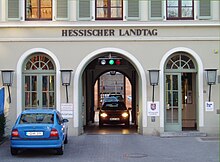
The palace complex serves as a place of work for the 118 elected MPs of the Hessian State Parliament. The historic rooms of the ducal palace itself are used for official receptions of President of the Parliament (German: Landtagspräsident), as well as for other celebrations. The former Music Hall is also used for public events and concerts. In the adjacent buildings – Gentleman's House, Wilhelmsbau and the former Administrative Court – the MP's offices and State Parliament administration are housed. There are also meeting rooms for committees and facilities for press conferences. The Parliament restaurant is housed in the basement. The Hessian State Government chaired by the Minister-President also has rooms which can be used during the plenary sessions. Additionally there are facilities for accommodating visitors who participate in the public meetings of the Landtag. The plenary hall has a large foyer, a public gallery, and an information center on the history of the Parliament. Today the Wilhelmbau houses the Wiesbaden studios of Hessischer Rundfunk and a well-known room used for national press conferences.
References
- City Palace at www.wiesbaden.de. Retrieved 10 February 2014.
- ^ Dr. Rolf Faber: "Biebrich, Usingen, Wiesbaden: Geschichte und Pracht nassauischer Schlösser" (English: History and Splendor of the Nassau Palaces) In: Jahrbuch des Rheingau-Taunus-Kries (Bad Schwalbach: District Committee of Rheingau-Taunus, 2001) Online Summary at nassau-info.de (in German) Retrieved 23 April 2012
- ^ Wiesbaden City Palace History on the official website of the City of Wiesbaden (in English), retrieved 25 April 2012.
- ^ Plenary Hall Official website (in German) Retrieved 25 April 2012
- ^ Eckhart G. Franz: The Chronicle of Hesse. (Dortmund: Chronik Verlag, 1991). Online Summary at nassau-info.de (in German) Retrieved 25 April 2012
- ^ Schlösser, Burgen, alte Mauern (English: Palaces, Castles, Old Walls), (Wiesbaden: Herausgegeben vom Hessendienst der Staatskanzlei, 1990) p. 371f. ISBN 3-89214-017-0
- ^ Klaus Kopp: "Die Herzöge von Nassau zwischen Revolution und Restauration" (English: The Duchy of Nassau between Restoration and Revolution" In: Yearbook of the Rheingau-Taunus-Kries (Bad Schwalbach: District Committee of Rheingau-Taunus, 2001). Online Summary at nassau-info.de (in German) Retrieved 25 April 2012
- Georg Schmidt-von Rhein: "Die Wiesbadener Revolution" In: Der weite Weg zum Parlament – Von der Monarchie zur Republik (Wiesbaden: Kur- und Verkehrsverein, 1998). ISBN 3-00-003125-1 Online summary (in German) Retrieved 25 April 2012
- Compact History of Wiesbaden (in German) on the official website of the City of Wiesbaden, retrieved 25 April 2012.
- Hogg, Ian V., German Order of Battle 1944: The regiments, formations and units of the German ground forces, London: Arms and Armour Press, 1975).
- ^ HR Wiesbaden Studios Official website (in German), retrieved 25 April 2012.
- ^ Plenary Chamber project Official website (in German) Retrieved 25 April 2012
- Rolf Bidlingmaier: Das Stadtschloss in Wiesbaden: Residenz der Herzöge von Nassau (Schnell & Steiner Verlag, 1st edition, 2012) ISBN 3795424291
- Manfred Laufs (ed.): "Philipp Hoffmann (1806–1889)" In: Arbeitshefte des Landesamtes für Denkmalpflege Hessen, Band 12 (Stuttgart: Theiss, 2007). ISBN 3-8062-2166-9
- History of the Palmengarten (in German) Retrieved 22 April 2012
- Peter Schabe: Felix Genzmer – Stadtbaumeister des Historismus in Wiesbaden (English: Master Builder of Wiesbaden), (Wiesbaden: Historische Kommission für Nassau, 1996).
- Hessian Landtag Official website (in German) Retrieved 25 April 2012
Literature
- Baedeker Wiesbaden Rheingau (Ostfildern-Kemnat: Karl Baedeker GmbH, 2001). ISBN 3-87954-076-4
- Gottfried Kiesow: Das verkannte Jahrhundert. Der Historismus am Beispiel Wiesbaden (Deutsche Stiftung Denkmalschutz, 2005). ISBN 3-936942-53-6
- Winfried Schüler: Das Herzogtum Nassau 1806–1866. Deutsche Geschichte im Kleinformat (Wiesbaden: Historische Kommission für Nassau, 2006). ISBN 3-930221-16-0
50°04′56″N 8°14′29″E / 50.082222°N 8.241389°E / 50.082222; 8.241389
Categories: